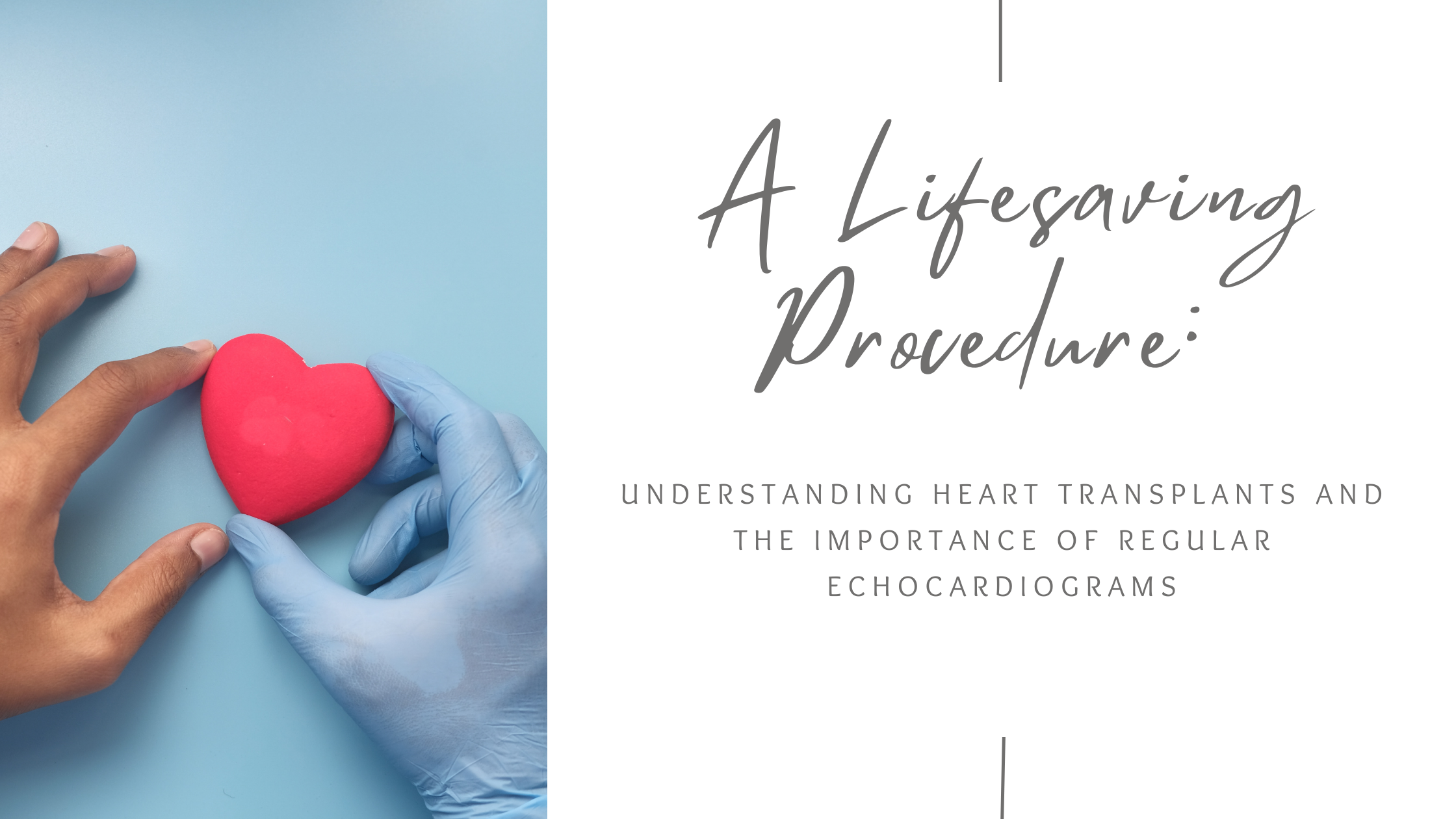A Lifesaving Procedure:

Understanding Heart Transplants and the Importance of Regular Echocardiograms
Simply put: a heart transplant is a procedure in which a failing heart is replaced with a donor heart. The goal of a cardiac transplant is not only to increase lifespan, but also quality of life. It sounds easy enough but there is so much to consider and investigate before a heart transplant can take place, and once completed, a heart transplant should be closely monitored.
In order to become a cardiac transplant candidate, a thorough screening will be conducted. A direct quote from the “Cardiac Transplantation: Eligibility and Listing Criteria in Canada 2012” states: “In general, cardiac transplantation can be considered in patients with late-stage heart disease who have received optimal medical and surgical (if appropriate) therapy, and who have an unacceptable quality of life and poor anticipated survival. Typically, this would include patients with: – late-stage heart failure due to any cause; – refractory life-threatening arrhythmias despite optimal medication, surgical, and device therapy; – refractory angina not amenable to further revascularization; – complex congenital heart disease with failed surgical palliation or not amenable to surgical palliation at acceptable risk.”
This is not the only criteria one must meet. A variety of other factors are also considered including: Pulmonary Hypertension, Age, Obesity, Malignancy, Diabetes (with end-organ damage), Renal Dysfunction, Peripheral Vascular Disease, tobacco/substance abuse, Infection, Psychosocial issues, Pulmonary or Liver Disease, Immune and/or ABO incompatibility and more. Just to name a few.
The guidelines are extremely detailed as donor numbers are very limited. The selection process aims to ensure the donor hearts are given to the that patients that are most likely to benefit and have a positive outcome.
Once a patient is added to the transplant list they will be monitored throughout their wait for a donation. Care and further education will be provided to the patient to monitor and manage their ailments and maintain a place on the transplant list. Placement of name on the list may be moved up or down as the patients’ health changes.
When the time comes that a donor heart is available, the patient and donor heart must be “Matched”. Factors in the matching process are: blood type, tissue type, organ size, urgency of need in the patient, patients age and the distance between the donor and the transplant hospital (as the heart will only survive 4-6 hours outside of a body).
The surgery typically takes between 3 – 5 hours to complete but every patient and surgery is different. Post op, the patient will stay in the cardiovascular intensive care until at least 2-3 weeks and the patient will receive a full rehabilitation program to assist in optimal recovery. Patients that have received a transplant will continue to be monitored closely – now it is to ensure we are watching for signs of rejection. It is common for transplant patients to complete checkups starting weekly, then biweekly, progressing to 3, 6, 9, 12, 18 and 24 months post op. Annual testing every year afterwards is very common but all patient care plans vary.
The transplant process is a long and grueling one. It is not for the faint of heart (no pun intended) and there is much to be considered when starting this journey. For the best patient outcomes, detailed workups on the patients’ health are required through every step of the process. Echocardiograms are vital in the process. Pre transplant, an echo can help assess heart function, detect abnormalities, provide detailed measurements such as ejection fraction (the hearts ability to pump oxygen-rich blood to the body) and so much more. An echo can in some cases be a first alert that a heart is failing and transplant may be needed.
As the candidate waits for transplant, echos are needed to monitor the patients health and position on the waitlist. Once the transplant has been received, the echo will be a long-term, non invasive, follow up that can ensure the donor heart is functioning correctly and rejection is not taking place. The echocardiogram is a key component in developing an optimal treatment plan and keeping patient outcomes as positive as possible.
If you or a loved one are waiting for a heart transplant, or if you have questions about cardiac health, reach out to your healthcare provider for advice and regular imaging tests to ensure optimal heart function.
“Heart Transplant.” Www.Heart.Org, https://www.heart.org/en/health-topics/congenital-heart-defects/ care-and-treatment-for-congenital-heart-defects/heart-transplant. Accessed 5 Feb. 2025. Heart Treatments - Heart Treatments | NHLBI, NIH. 24 Mar. 2022, https://www.nhlbi.nih.gov/health/heart-treatments-procedures. 6 Things to Know About the Heart Transplant Process | Temple Health. https://www.templehealth.org/about/blog/why-temple-is-a-leader-in-heart-transplants. Accessed 5 Feb. 2025. Heart Transplant Clinic | University of Ottawa Heart Institute. 15 Sept. 2015, https://www.ottawaheart.ca/clinic/heart-transplant-clinic. Services, Alberta Health. “Foothills Medical Centre - Heart Transplant - Southern Alberta Transplant Program.” Alberta Health Services, https://www.albertahealthservices.ca/findhealth/Service.aspx?id=1736&serviceAtFacilityID=1025075. Accessed 5 Feb. 2025. “Heart Transplant Surgery.” Heart and Stroke Foundation of Canada, https://www.heartandstroke.ca/en/heart-disease/treatments/surgery-and-other-procedures/ heart-transplant-surgery/. Accessed 5 Feb. 2025. Learn about the Donor Matching System - OPTN. https://optn.transplant.hrsa.gov/patients/about-donation/donor-matching-system/. Accessed 5 Feb. 2025. Canadian Cardiovascular Society. Cardiac Transplantation Eligibility and Listing Criteria in Canada. https://ccs.ca/app/uploads/2020/12/CCTN_Cardiac_Transplantation_Eligibility_and_Listing_Criteria_in_Canada_2012.pdf. Accessed 5 Feb. 2025.
